SEO
Google Patent for Modifying Results Based on Generic Ratings
Bill Slawski recently called attention to a patent that describes a way to apply generic ratings to content as part of a process of modifying search results. The patent applies to search results, media content, books, websites and games and describes a way to show modified search results where some of the results are blocked from being displayed.
The patent mentions the phrase “search results” 95 times and the phrase “search result” 40 times.
So if you are interested in search, then this patent may be of interest, particularly if your practice of search encompasses text, video, audio and other forms of media.
Caveat About Google Patents
Google files many patents but it rarely confirms whether or not the algorithm described in the patent is in use in the search results.
At this point nobody knows whether the algorithms described in this patent are currently in use or will be in use.
How to Understand this Patent
In order to understand any patent (or research paper) it’s always a good idea to start reading from the beginning of the document. The beginning of the document is where it tells you what the patent is about.
People who scroll through the patent to locate the “interesting parts” tend to misunderstand what the patent is about because they don’t know the context of those “interesting parts.”
So if we begin at the start of the document, the patent abstract tells us what the patent does and how it does it.
The Problem that the Patent Solves
The section of the patent titled, Background, tells us the problem that this patent solves.
It states that users are interested in accessing content from all over the world. But the problem with getting that content is that different rating systems apply in every country.
Here is what the problem that the patent says it solves:
“Users are interested in accessing content (e.g., television programs, movies, books, videos, music, news articles, Web sites, etc.) that originates from many different countries, regions, or other groups.
Each country, region, or group may use a different rating system used to indicate content which contains material (e.g., violence, pornography, etc.) or which may be unsuitable for particular ages.
However, it can be difficult to understand the rating systems of different countries to filter content.
Accordingly, it is desirable to provide new methods, systems, and media for presenting content based on a generic content rating.”
What the Patent Does
The abstract at the beginning of the patent lists multiple things that the invention described by the patent does.
It begins by stating that it’s a way to present content based on generic ratings.
“Methods, systems, and media for presenting content based on a generic rating are provided.”
Generic Ratings
One of the prominent features of this patent is how it takes localized ratings, ratings from different countries and then converts them into what Google calls, “generic ratings.”
Generic ratings is a standardized rating system that an algorithm can use to rank and show the content that a user requires.
In this way the algorithm can apply a ratings standard regardless of what country the user is in.
In the below description, the patent uses the name “Process 700” to represent the algorithm.
The patent states:
“Process 700 can convert the content ratings associated with the received search results to generic content ratings….
As a specific example, in instances where a country-specific content rating is a United States content rating of “TV-G,” process 700 can determine that the generic content rating is to be “suitable for all ages.
Process 700 can use any suitable information and/or technique(s) to convert a country-specific content rating to a generic content rating.”
How the Process Does What it Does
Next it goes on to list the different things that the invention does.
This part is interesting because it provides the background information for understanding what it does and how it does it.
I have reformatted the description to make it easier to understand.
This is how it explains what the patent does:
“In some implementations, the method comprises:
- receiving search results;
- determining country-specific content ratings associated with the search results;
- converting the country-specific content ratings to generic content ratings associated with the search results;
- determining that at least one search result is to be blocked based on the generic content ratings and a user-selected generic content rating restriction;
- in response to determining that a search result is to be blocked, removing the search result from the search results to create modified search results;
- causing the modified search results to be presented;
- receiving a selection of content from the presented search results;
- determining a country-specific content rating associated with the selected content;
- converting the country-specific content rating to a generic content rating;
- determining that the selected content is not to be blocked based on the generic content rating and the user-selected generic content rating restriction; and causing the selected content to be presented.”
There are twenty one things listed that this invention does.
Here is a restated (and reformatted) version of the above description that is found in the section of the patent called Claims.
Out of the 21 claims made for the patent, this is the first claim:
“A method for presenting content based on a generic content rating, the method comprising:
- receiving one or more search results corresponding to a search query;
- determining location-specific content ratings associated with the one or more received search results;
- converting, using a hardware processor, the location-specific content ratings to generic content ratings associated with the one or more search results by transmitting an indicator of the location-specific content ratings to a server and receiving, from the server, the generic content ratings;
- determining that at least one search result is to be blocked based on the generic content ratings associated with the one or more search results and a user-selected generic content rating restriction;
- in response to determining that at least one search result is to be blocked, removing the at least one search result from the one or more search results to create modified search results; and causing the modified search results to be presented.”
The other 20 claims go into fine detail of how the first claim is accomplished, like claim number 8:
“A system for presenting content based on a generic content rating…”
Where the Process Happens
The patent describes the devices that a user will use when retrieving the content that is subject to being ranked by ratings.
This is important because it tells us what the context of the ratings and rankings are.
The context is accessing the content through mobile devices, desktop devices, but also through devices like televisions.
This is what the patent says are examples of user devices where the ratings-ranked content will be shown:
“User device …can include any one or more user devices suitable for receiving and/or presenting content.
For example, in some implementations, user device …can include mobile devices, such as a mobile phone, a tablet computer, a laptop computer, a vehicle (e.g., a car, a boat, an airplane, or any other suitable vehicle) entertainment system, a portable media player, or any other suitable mobile device.
As another example, in some implementations, user device …can include non-mobile devices such as a desktop computer, a set-top box, a television, a streaming media player, a game console, or any other suitable non-mobile device.”
The Kinds of Content that is Rated and Ranked
The patent describes the kinds of content that is rated and it seems to cover almost every kind of content that there is at this time.
The patent describes a process of receiving content and then rating that content. The content that is received and rated can be search results, websites, movies and even books.
Here is what it says:
“In some implementations, the mechanisms described herein can receive content (e.g., search results, media content, books, Web sites, and/or any other suitable content) from different countries, locations, and/or groups, and can convert a specific content rating associated with the content to a generic content rating.”
Next it describes using a user-selected content rating to rank the content. For example, if someone is on their phone and they want something that is child-safe.
The patent describes the process:
“In some implementations, the mechanisms can determine a user-selected generic content rating restriction and can determine whether the received content is to be blocked based on the user-selected generic content rating restriction and the generic content rating corresponding to the received content.
In some implementations, in response to determining that the content is not to be blocked, the mechanisms can cause the content to be presented on a user device.”
Takeaway About Modified Search Results
Something that isn’t widely understood is that there are many ways to rank a search result, and those ranking functions don’t always happen in the ranking engine where traditional ranking factors like links and so on happen.
This is the situation where a user asks a query and Google ranks results and then the algorithm modifies the search results and shows the modified search results.
The phrase “modified search results” is repeated twenty times in this patent.
“…removing the at least one search result from the one or more search results to create modified search results; and causing the modified search results to be presented.”
This is something to keep in mind when analyzing the search results and trying to understand why something is ranked. It’s not always because of “ranking factors” because there are many other ranking related processes going on.
Citations
Read Bill Slawski’s Article:
Generic Content Ratings Based on Location
Read the Search Modification Based on Generic Ratings Patent
Methods, systems, and media for presenting content based on a generic rating
SEO
How To Write ChatGPT Prompts To Get The Best Results

ChatGPT is a game changer in the field of SEO. This powerful language model can generate human-like content, making it an invaluable tool for SEO professionals.
However, the prompts you provide largely determine the quality of the output.
To unlock the full potential of ChatGPT and create content that resonates with your audience and search engines, writing effective prompts is crucial.
In this comprehensive guide, we’ll explore the art of writing prompts for ChatGPT, covering everything from basic techniques to advanced strategies for layering prompts and generating high-quality, SEO-friendly content.
Writing Prompts For ChatGPT
What Is A ChatGPT Prompt?
A ChatGPT prompt is an instruction or discussion topic a user provides for the ChatGPT AI model to respond to.
The prompt can be a question, statement, or any other stimulus to spark creativity, reflection, or engagement.
Users can use the prompt to generate ideas, share their thoughts, or start a conversation.
ChatGPT prompts are designed to be open-ended and can be customized based on the user’s preferences and interests.
How To Write Prompts For ChatGPT
Start by giving ChatGPT a writing prompt, such as, “Write a short story about a person who discovers they have a superpower.”
ChatGPT will then generate a response based on your prompt. Depending on the prompt’s complexity and the level of detail you requested, the answer may be a few sentences or several paragraphs long.
Use the ChatGPT-generated response as a starting point for your writing. You can take the ideas and concepts presented in the answer and expand upon them, adding your own unique spin to the story.
If you want to generate additional ideas, try asking ChatGPT follow-up questions related to your original prompt.
For example, you could ask, “What challenges might the person face in exploring their newfound superpower?” Or, “How might the person’s relationships with others be affected by their superpower?”
Remember that ChatGPT’s answers are generated by artificial intelligence and may not always be perfect or exactly what you want.
However, they can still be a great source of inspiration and help you start writing.
Must-Have GPTs Assistant
I recommend installing the WebBrowser Assistant created by the OpenAI Team. This tool allows you to add relevant Bing results to your ChatGPT prompts.
This assistant adds the first web results to your ChatGPT prompts for more accurate and up-to-date conversations.
It is very easy to install in only two clicks. (Click on Start Chat.)
For example, if I ask, “Who is Vincent Terrasi?,” ChatGPT has no answer.
With WebBrower Assistant, the assistant creates a new prompt with the first Bing results, and now ChatGPT knows who Vincent Terrasi is.
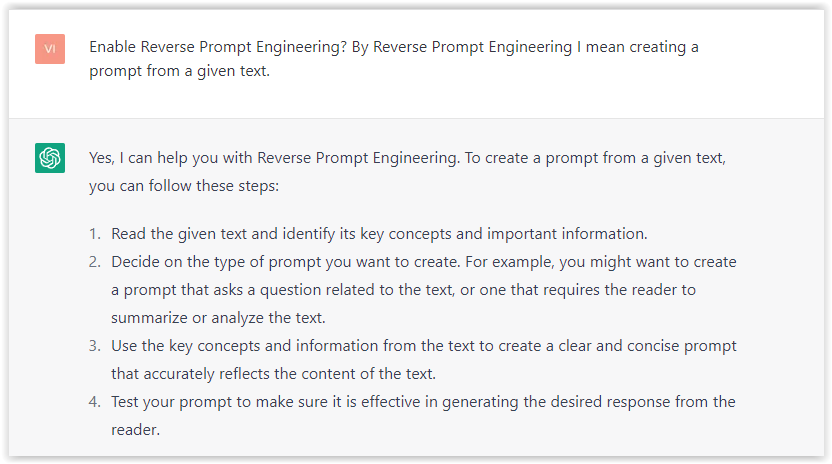 Screenshot from ChatGPT, March 2023
Screenshot from ChatGPT, March 2023You can test other GPT assistants available in the GPTs search engine if you want to use Google results.
Master Reverse Prompt Engineering
ChatGPT can be an excellent tool for reverse engineering prompts because it generates natural and engaging responses to any given input.
By analyzing the prompts generated by ChatGPT, it is possible to gain insight into the model’s underlying thought processes and decision-making strategies.
One key benefit of using ChatGPT to reverse engineer prompts is that the model is highly transparent in its decision-making.
This means that the reasoning and logic behind each response can be traced, making it easier to understand how the model arrives at its conclusions.
Once you’ve done this a few times for different types of content, you’ll gain insight into crafting more effective prompts.
Prepare Your ChatGPT For Generating Prompts
First, activate the reverse prompt engineering.
- Type the following prompt: “Enable Reverse Prompt Engineering? By Reverse Prompt Engineering I mean creating a prompt from a given text.”
 Screenshot from ChatGPT, March 2023
Screenshot from ChatGPT, March 2023ChatGPT is now ready to generate your prompt. You can test the product description in a new chatbot session and evaluate the generated prompt.
- Type: “Create a very technical reverse prompt engineering template for a product description about iPhone 11.”
 Screenshot from ChatGPT, March 2023
Screenshot from ChatGPT, March 2023The result is amazing. You can test with a full text that you want to reproduce. Here is an example of a prompt for selling a Kindle on Amazon.
- Type: “Reverse Prompt engineer the following {product), capture the writing style and the length of the text :
product =”
 Screenshot from ChatGPT, March 2023
Screenshot from ChatGPT, March 2023I tested it on an SEJ blog post. Enjoy the analysis – it is excellent.
- Type: “Reverse Prompt engineer the following {text}, capture the tone and writing style of the {text} to include in the prompt :
text = all text coming from https://www.searchenginejournal.com/google-bard-training-data/478941/”
 Screenshot from ChatGPT, March 2023
Screenshot from ChatGPT, March 2023But be careful not to use ChatGPT to generate your texts. It is just a personal assistant.
Go Deeper
Prompts and examples for SEO:
- Keyword research and content ideas prompt: “Provide a list of 20 long-tail keyword ideas related to ‘local SEO strategies’ along with brief content topic descriptions for each keyword.”
- Optimizing content for featured snippets prompt: “Write a 40-50 word paragraph optimized for the query ‘what is the featured snippet in Google search’ that could potentially earn the featured snippet.”
- Creating meta descriptions prompt: “Draft a compelling meta description for the following blog post title: ’10 Technical SEO Factors You Can’t Ignore in 2024′.”
Important Considerations:
- Always Fact-Check: While ChatGPT can be a helpful tool, it’s crucial to remember that it may generate inaccurate or fabricated information. Always verify any facts, statistics, or quotes generated by ChatGPT before incorporating them into your content.
- Maintain Control and Creativity: Use ChatGPT as a tool to assist your writing, not replace it. Don’t rely on it to do your thinking or create content from scratch. Your unique perspective and creativity are essential for producing high-quality, engaging content.
- Iteration is Key: Refine and revise the outputs generated by ChatGPT to ensure they align with your voice, style, and intended message.
Additional Prompts for Rewording and SEO:
– Rewrite this sentence to be more concise and impactful.
– Suggest alternative phrasing for this section to improve clarity.
– Identify opportunities to incorporate relevant internal and external links.
– Analyze the keyword density and suggest improvements for better SEO.
Remember, while ChatGPT can be a valuable tool, it’s essential to use it responsibly and maintain control over your content creation process.
Experiment And Refine Your Prompting Techniques
Writing effective prompts for ChatGPT is an essential skill for any SEO professional who wants to harness the power of AI-generated content.
Hopefully, the insights and examples shared in this article can inspire you and help guide you to crafting stronger prompts that yield high-quality content.
Remember to experiment with layering prompts, iterating on the output, and continually refining your prompting techniques.
This will help you stay ahead of the curve in the ever-changing world of SEO.
More resources:
Featured Image: Tapati Rinchumrus/Shutterstock
SEO
Measuring Content Impact Across The Customer Journey

Understanding the impact of your content at every touchpoint of the customer journey is essential – but that’s easier said than done. From attracting potential leads to nurturing them into loyal customers, there are many touchpoints to look into.
So how do you identify and take advantage of these opportunities for growth?
Watch this on-demand webinar and learn a comprehensive approach for measuring the value of your content initiatives, so you can optimize resource allocation for maximum impact.
You’ll learn:
- Fresh methods for measuring your content’s impact.
- Fascinating insights using first-touch attribution, and how it differs from the usual last-touch perspective.
- Ways to persuade decision-makers to invest in more content by showcasing its value convincingly.
With Bill Franklin and Oliver Tani of DAC Group, we unravel the nuances of attribution modeling, emphasizing the significance of layering first-touch and last-touch attribution within your measurement strategy.
Check out these insights to help you craft compelling content tailored to each stage, using an approach rooted in first-hand experience to ensure your content resonates.
Whether you’re a seasoned marketer or new to content measurement, this webinar promises valuable insights and actionable tactics to elevate your SEO game and optimize your content initiatives for success.
View the slides below or check out the full webinar for all the details.
SEO
How to Find and Use Competitor Keywords
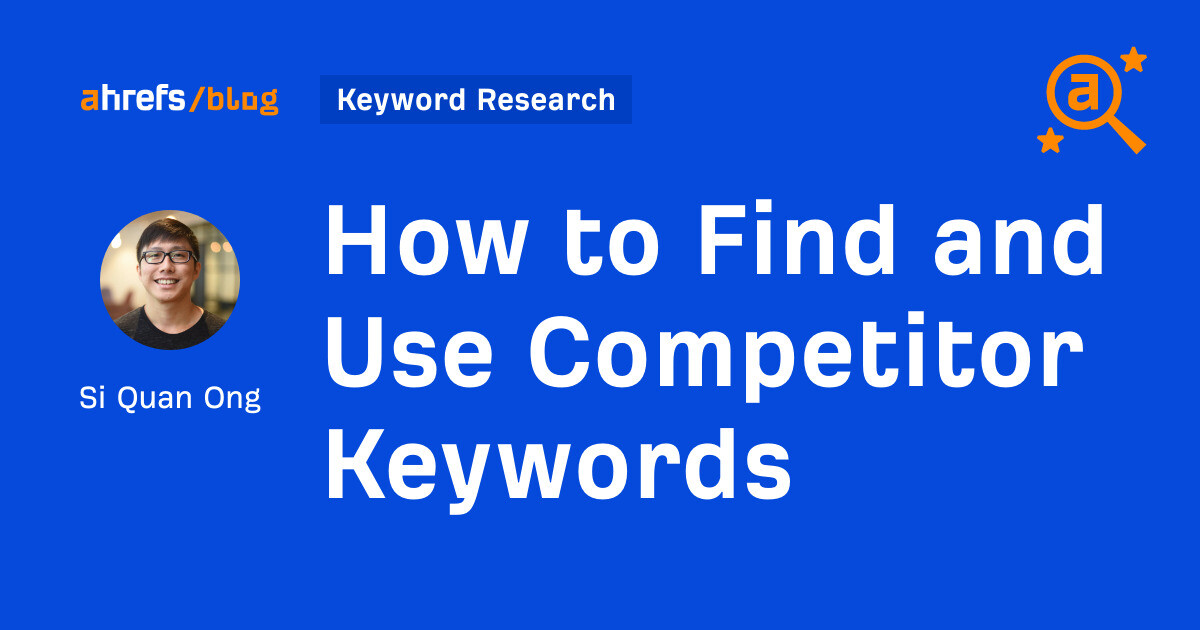
Competitor keywords are the keywords your rivals rank for in Google’s search results. They may rank organically or pay for Google Ads to rank in the paid results.
Knowing your competitors’ keywords is the easiest form of keyword research. If your competitors rank for or target particular keywords, it might be worth it for you to target them, too.
There is no way to see your competitors’ keywords without a tool like Ahrefs, which has a database of keywords and the sites that rank for them. As far as we know, Ahrefs has the biggest database of these keywords.
How to find all the keywords your competitor ranks for
- Go to Ahrefs’ Site Explorer
- Enter your competitor’s domain
- Go to the Organic keywords report
The report is sorted by traffic to show you the keywords sending your competitor the most visits. For example, Mailchimp gets most of its organic traffic from the keyword “mailchimp.”


Since you’re unlikely to rank for your competitor’s brand, you might want to exclude branded keywords from the report. You can do this by adding a Keyword > Doesn’t contain filter. In this example, we’ll filter out keywords containing “mailchimp” or any potential misspellings:
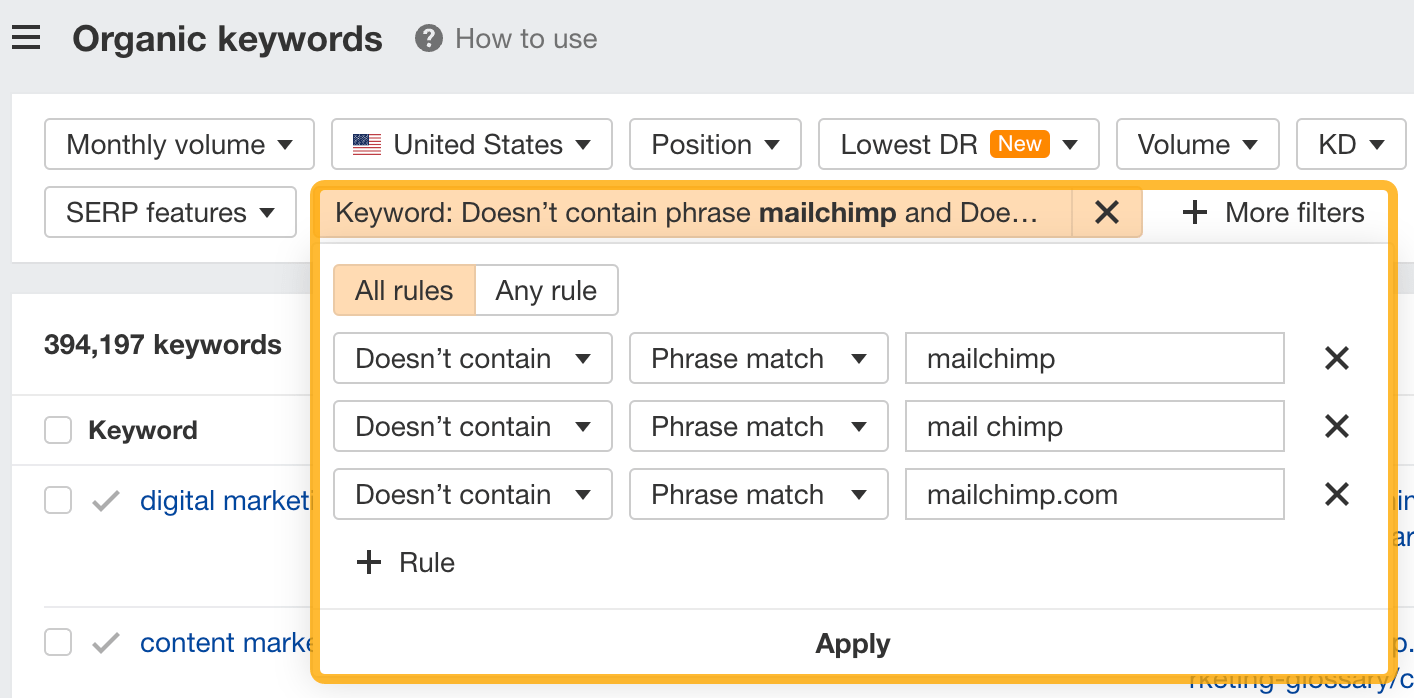

If you’re a new brand competing with one that’s established, you might also want to look for popular low-difficulty keywords. You can do this by setting the Volume filter to a minimum of 500 and the KD filter to a maximum of 10.
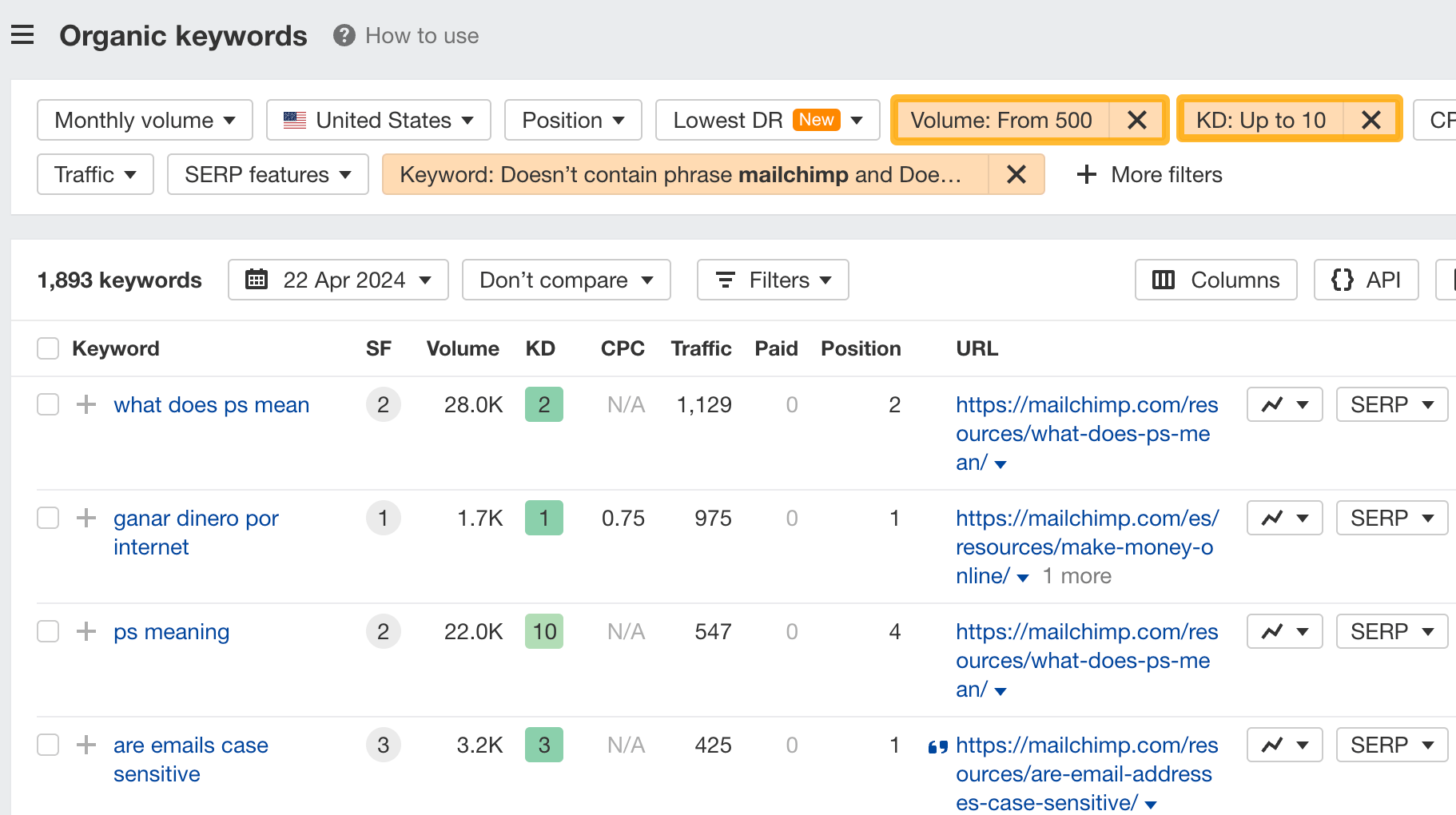

How to find keywords your competitor ranks for, but you don’t
- Go to Competitive Analysis
- Enter your domain in the This target doesn’t rank for section
- Enter your competitor’s domain in the But these competitors do section
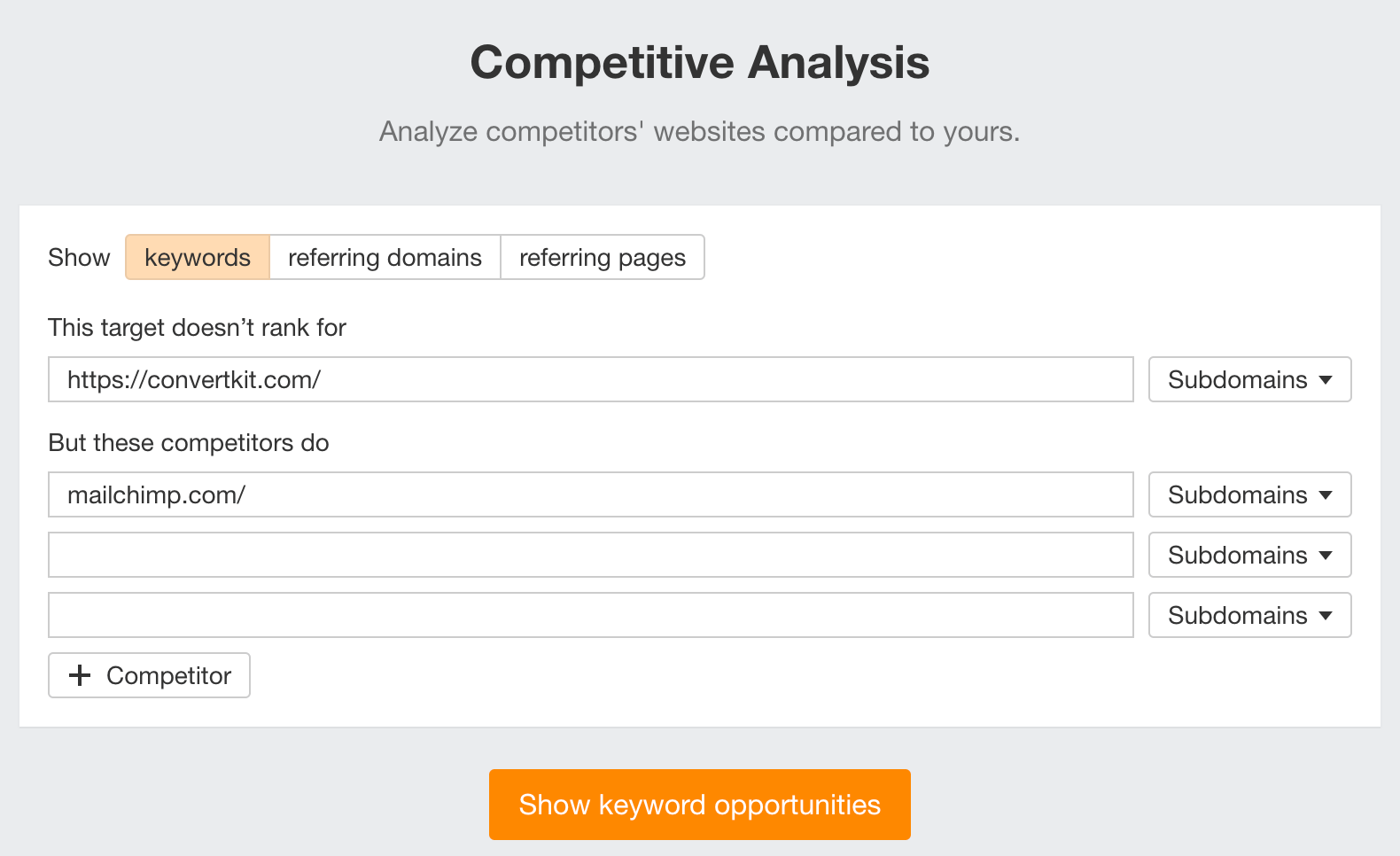

Hit “Show keyword opportunities,” and you’ll see all the keywords your competitor ranks for, but you don’t.
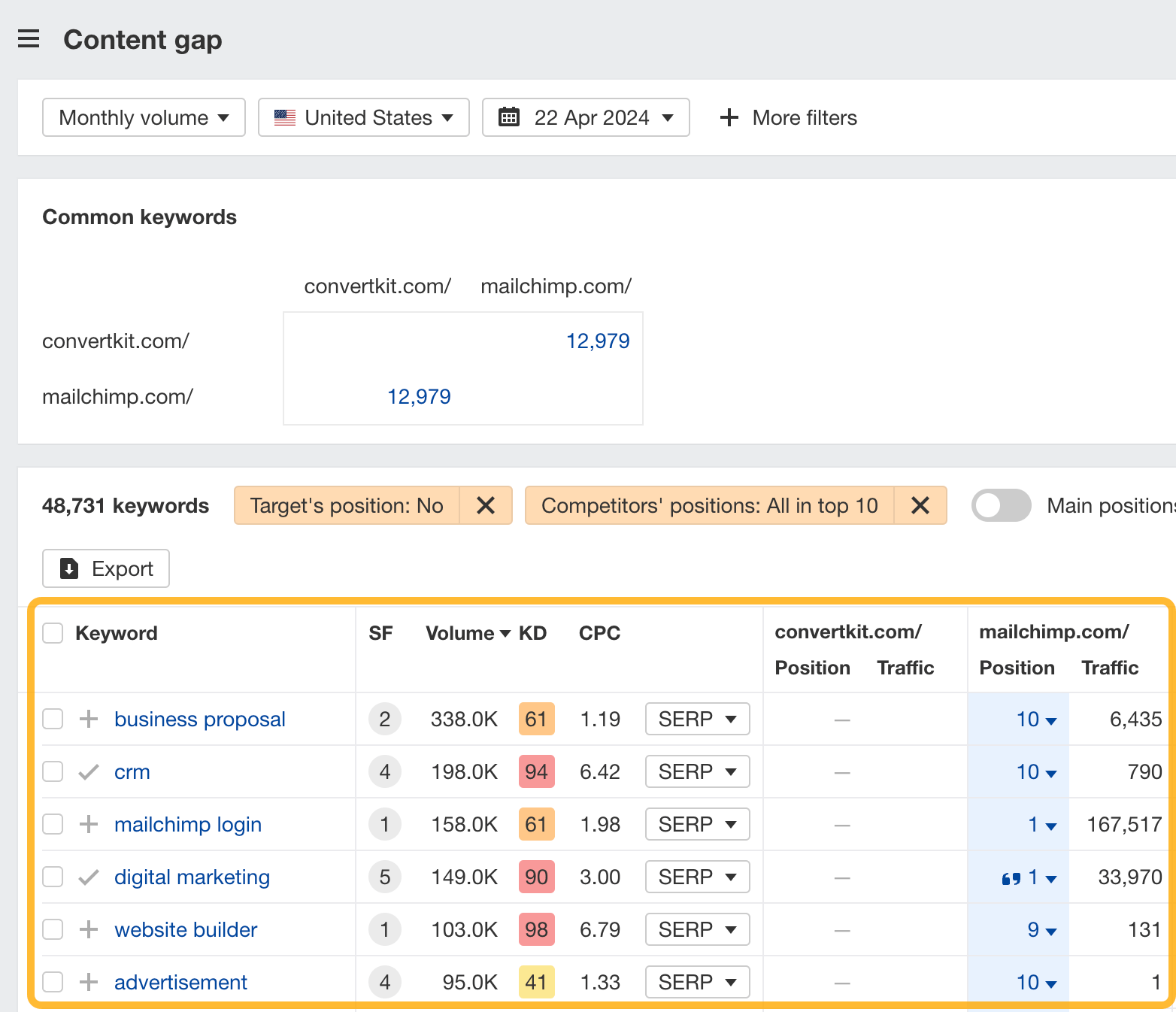

You can also add a Volume and KD filter to find popular, low-difficulty keywords in this report.
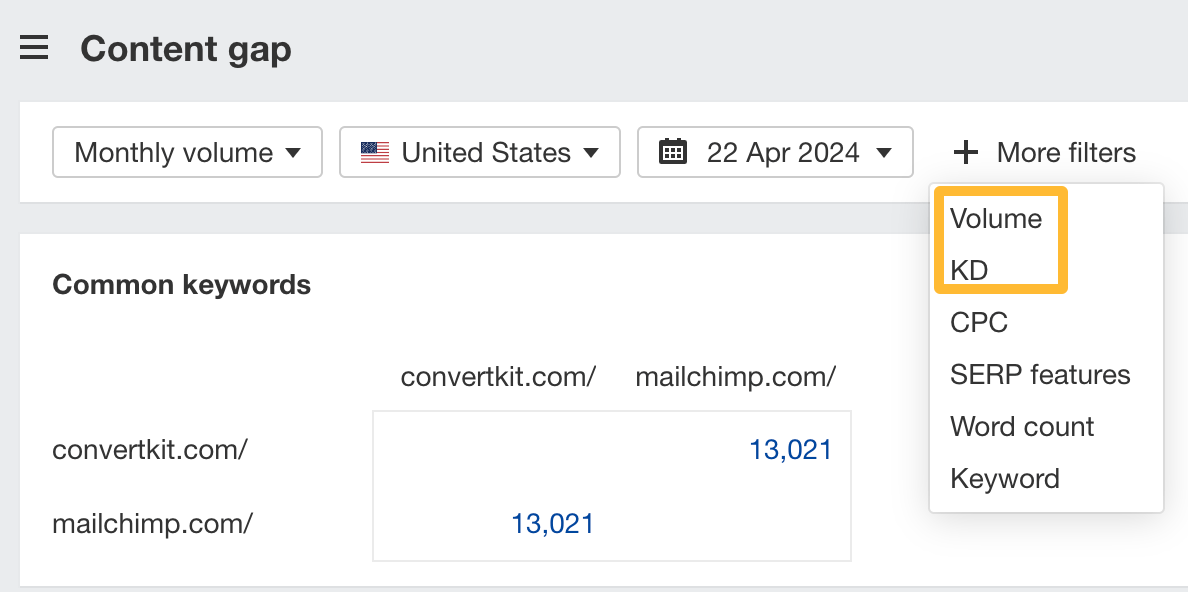

How to find keywords multiple competitors rank for, but you don’t
- Go to Competitive Analysis
- Enter your domain in the This target doesn’t rank for section
- Enter the domains of multiple competitors in the But these competitors do section
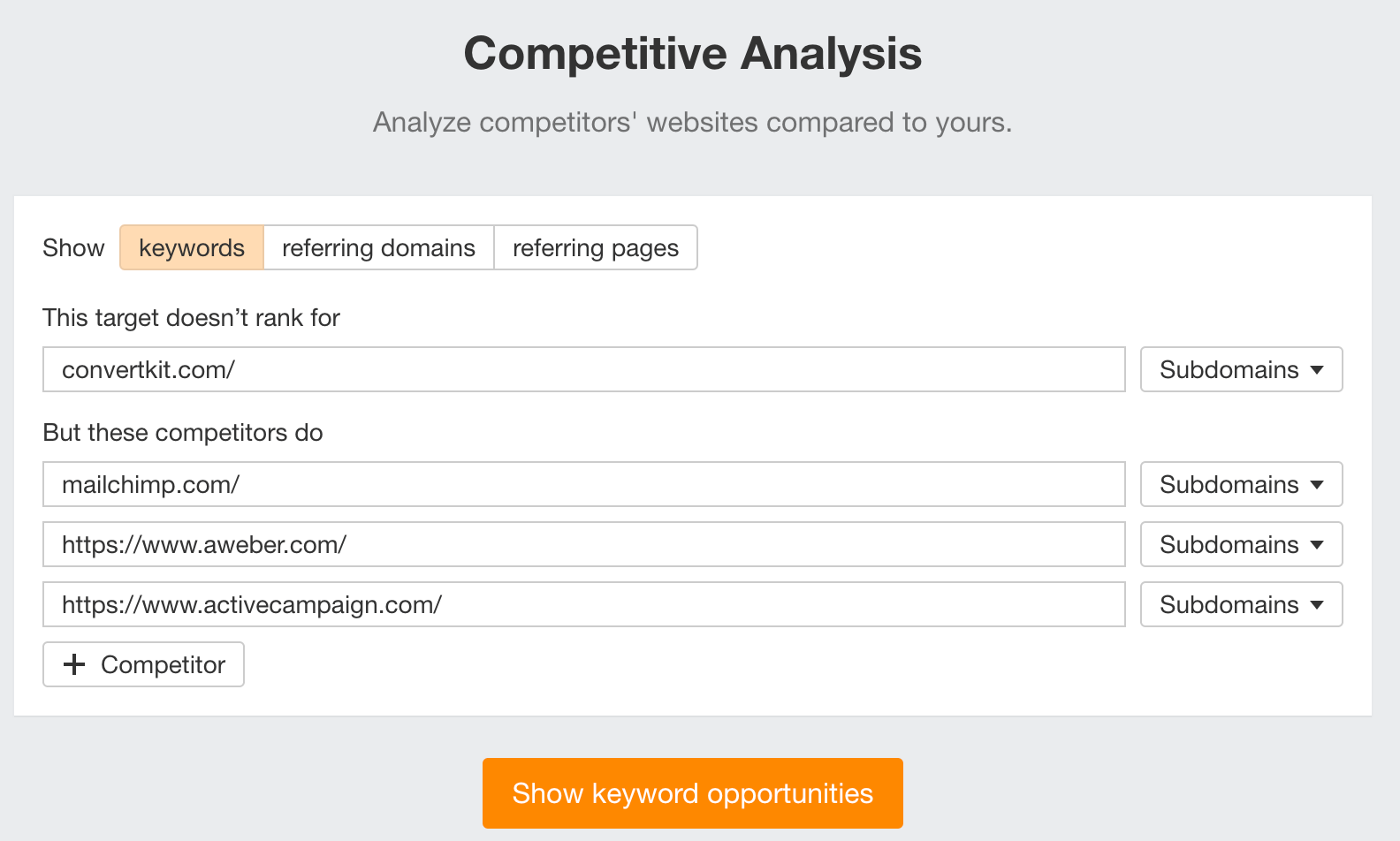

You’ll see all the keywords that at least one of these competitors ranks for, but you don’t.
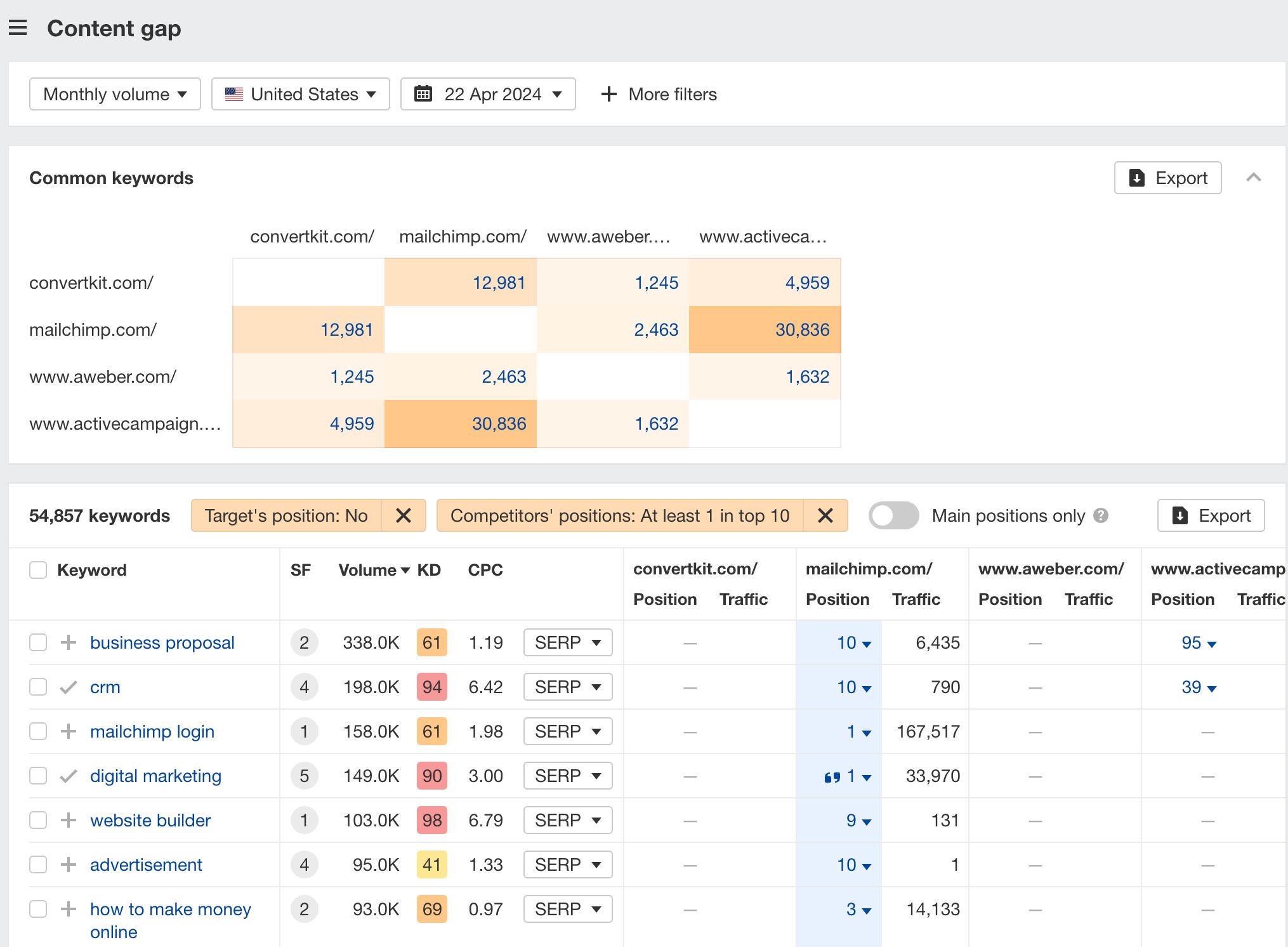

You can also narrow the list down to keywords that all competitors rank for. Click on the Competitors’ positions filter and choose All 3 competitors:
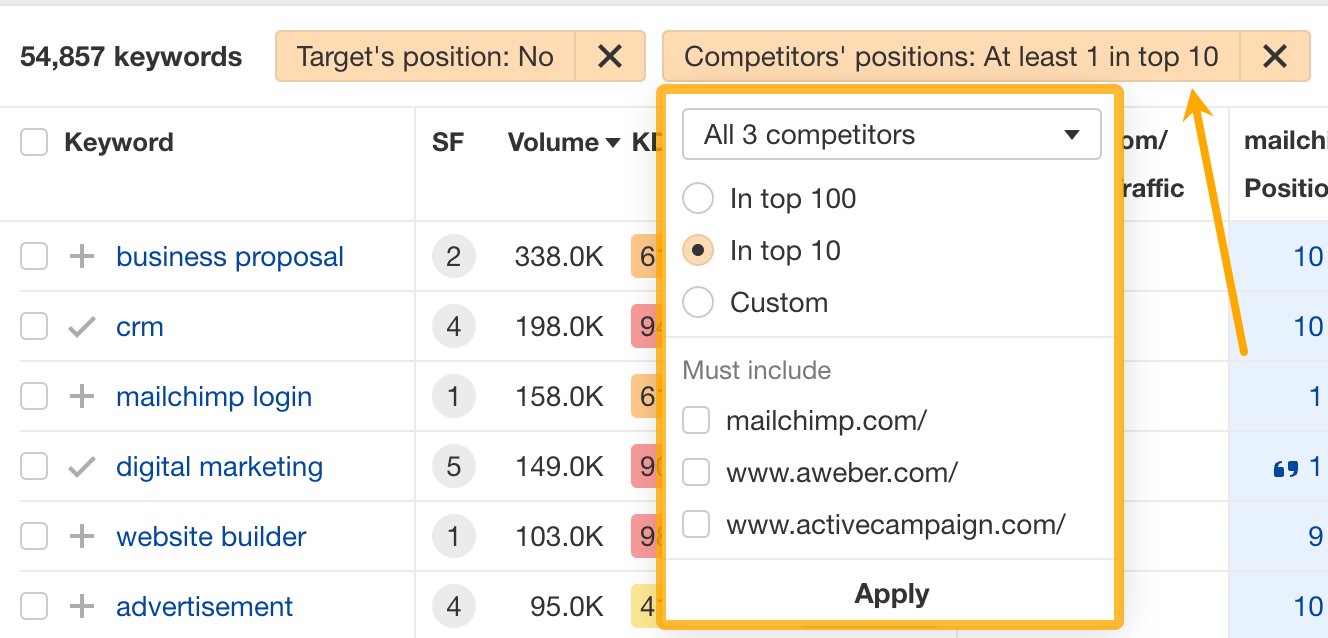

- Go to Ahrefs’ Site Explorer
- Enter your competitor’s domain
- Go to the Paid keywords report


This report shows you the keywords your competitors are targeting via Google Ads.
Since your competitor is paying for traffic from these keywords, it may indicate that they’re profitable for them—and could be for you, too.
You know what keywords your competitors are ranking for or bidding on. But what do you do with them? There are basically three options.
1. Create pages to target these keywords
You can only rank for keywords if you have content about them. So, the most straightforward thing you can do for competitors’ keywords you want to rank for is to create pages to target them.
However, before you do this, it’s worth clustering your competitor’s keywords by Parent Topic. This will group keywords that mean the same or similar things so you can target them all with one page.
Here’s how to do that:
- Export your competitor’s keywords, either from the Organic Keywords or Content Gap report
- Paste them into Keywords Explorer
- Click the “Clusters by Parent Topic” tab
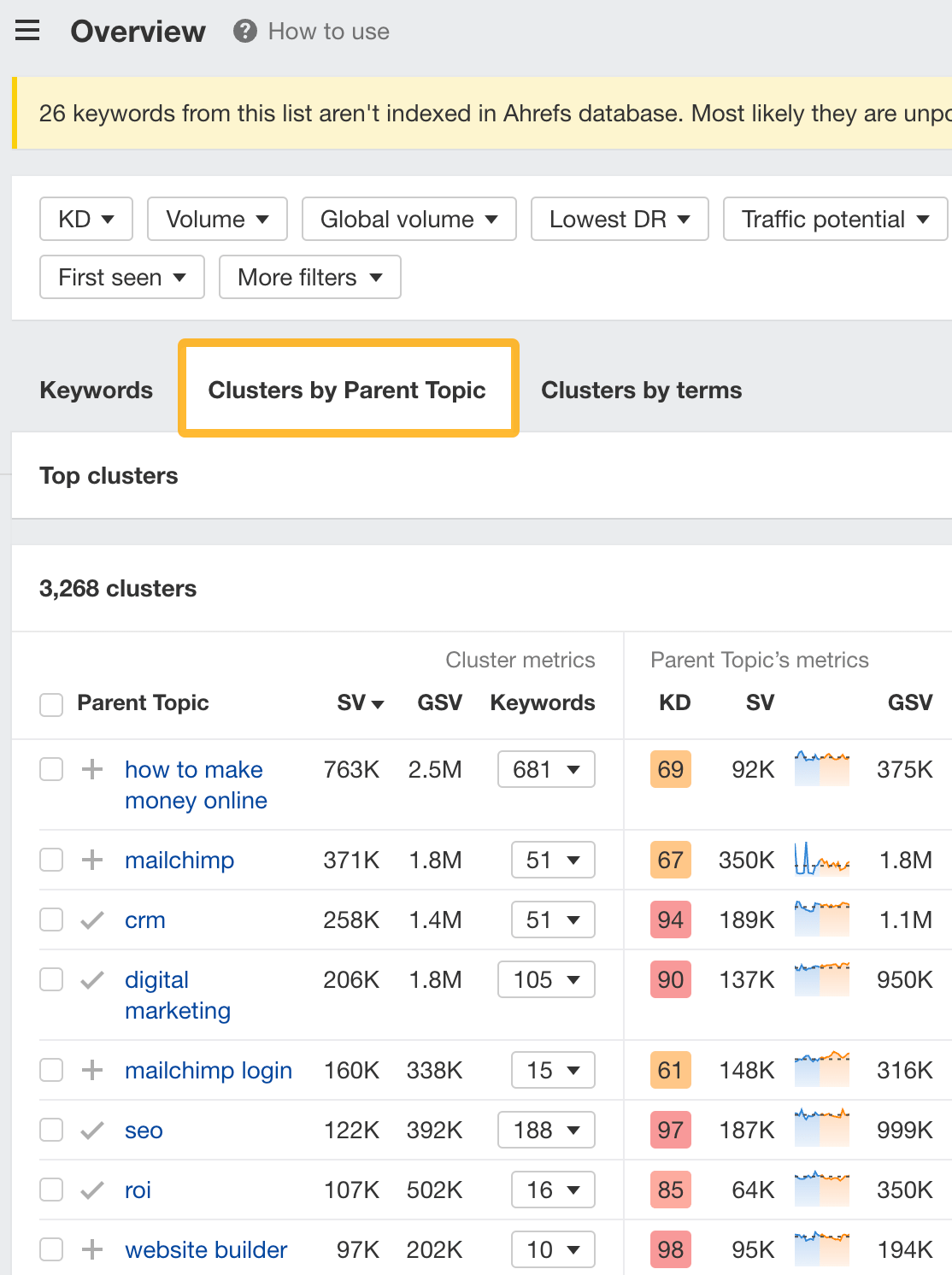

For example, MailChimp ranks for keywords like “what is digital marketing” and “digital marketing definition.” These and many others get clustered under the Parent Topic of “digital marketing” because people searching for them are all looking for the same thing: a definition of digital marketing. You only need to create one page to potentially rank for all these keywords.
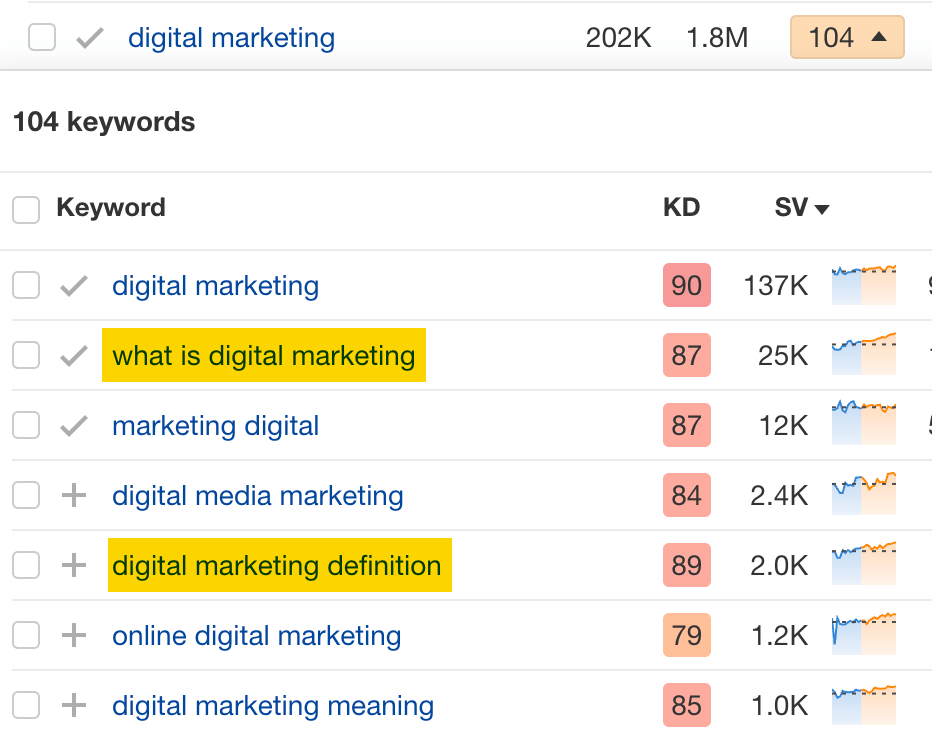

2. Optimize existing content by filling subtopics
You don’t always need to create new content to rank for competitors’ keywords. Sometimes, you can optimize the content you already have to rank for them.
How do you know which keywords you can do this for? Try this:
- Export your competitor’s keywords
- Paste them into Keywords Explorer
- Click the “Clusters by Parent Topic” tab
- Look for Parent Topics you already have content about
For example, if we analyze our competitor, we can see that seven keywords they rank for fall under the Parent Topic of “press release template.”


If we search our site, we see that we already have a page about this topic.


If we click the caret and check the keywords in the cluster, we see keywords like “press release example” and “press release format.”
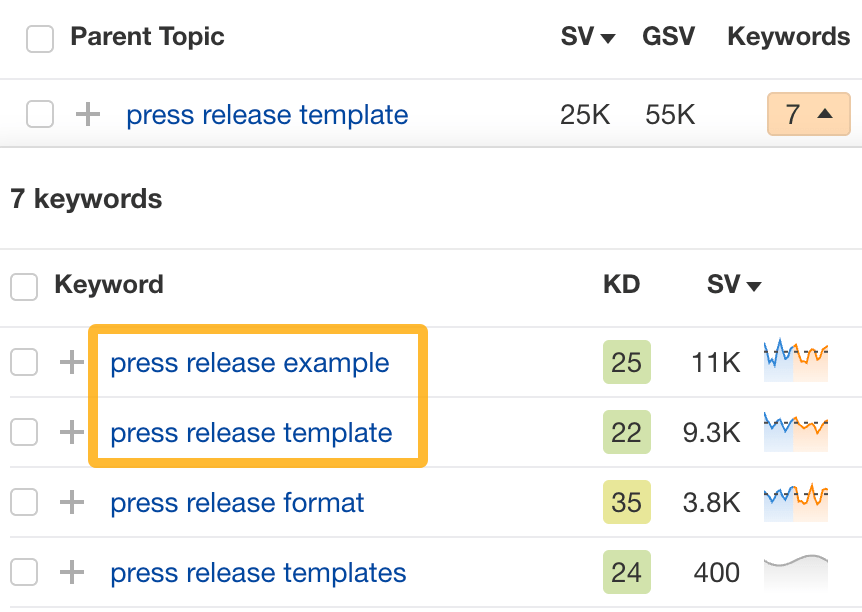

To rank for the keywords in the cluster, we can probably optimize the page we already have by adding sections about the subtopics of “press release examples” and “press release format.”
3. Target these keywords with Google Ads
Paid keywords are the simplest—look through the report and see if there are any relevant keywords you might want to target, too.
For example, Mailchimp is bidding for the keyword “how to create a newsletter.”


If you’re ConvertKit, you may also want to target this keyword since it’s relevant.
If you decide to target the same keyword via Google Ads, you can hover over the magnifying glass to see the ads your competitor is using.
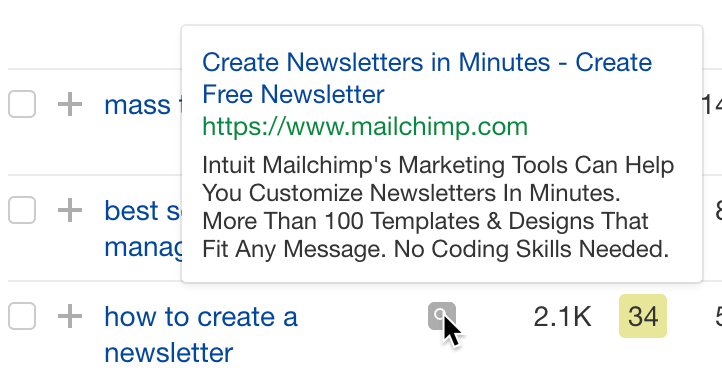

You can also see the landing page your competitor directs ad traffic to under the URL column.


Learn more
Check out more tutorials on how to do competitor keyword analysis:
-

 PPC5 days ago
PPC5 days ago19 Best SEO Tools in 2024 (For Every Use Case)
-
SEARCHENGINES7 days ago
Daily Search Forum Recap: April 17, 2024
-
SEARCHENGINES6 days ago
Daily Search Forum Recap: April 18, 2024
-
SEARCHENGINES5 days ago
Daily Search Forum Recap: April 19, 2024
-

 MARKETING6 days ago
MARKETING6 days agoEcommerce evolution: Blurring the lines between B2B and B2C
-

 SEO6 days ago
SEO6 days ago2024 WordPress Vulnerability Report Shows Errors Sites Keep Making
-

 WORDPRESS5 days ago
WORDPRESS5 days agoHow to Make $5000 of Passive Income Every Month in WordPress
-

 WORDPRESS6 days ago
WORDPRESS6 days ago10 Amazing WordPress Design Resouces – WordPress.com News















You must be logged in to post a comment Login